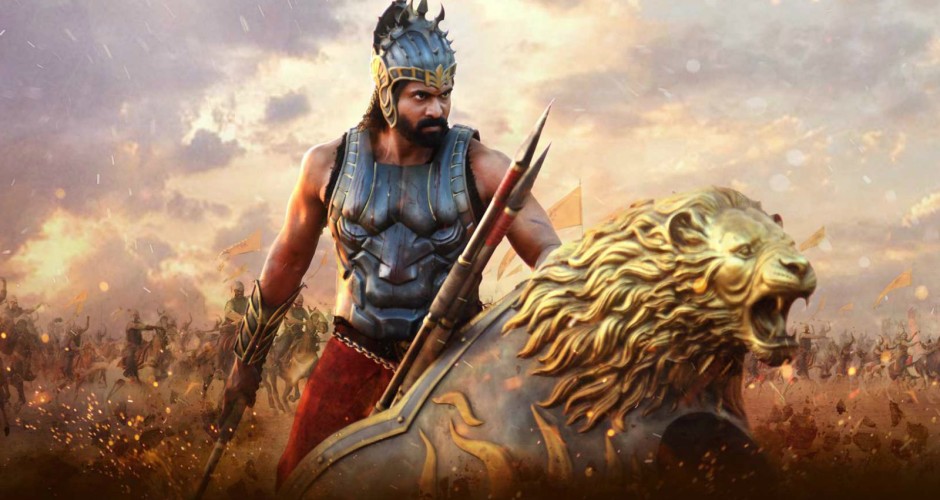The blockbuster movie, Baahubali (the Strong-Armed One), has been a record-breaking success since it was first released several weeks ago. It has made a huge splash, not just for its commercial success, but for its unique positioning as an epic fantasy sourced in Hindu thought and culture. The movie, in the title screen, is subtitled as “The Beginning” as an indication that this is the first of a two-part series. But Baahubali is a beginning to more than just that. I hope that the title proves to be prophetic as the beginning of a new phase in mainstream Bollywood film.
Baahubali numbers among my most favorite films ever, but, in the interests of objectivity, some negatives should be noted first. For all the money spent on the film and the amount of time it was in production, the CGI and special effects in many places are quite poor in quality.
Some of the fighting and other action scenes could have been significantly improved—as the weapons looked almost cartoonish or the sequencing was not of the highest caliber in places. Also, the storyline itself is fairly trite and predictable—much of it is over-the-top and it lacks the subtlety and nuance of truly great storytelling. It cannot be classified as great art in that sense.
But these foibles are easily forgiven because of the spirit of what Baahubali is and what it represents. There is such a strong, confident, positive, can-do energy that pulsates through the movie and is quite contagious. Even the scenes that are ridiculously over-the-top and cheesy are still highly enjoyable, because it is precisely that overzealous energy, that larger than life feeling, that makes Indian cinema so endearing to so many of us.
The story is inspiring if not intellectually stimulating, and the characters are ones you root for and easily come to love. There is a sweet love story to add the necessary element of romance.
One of the most appealing things about the movie is the strong, positive values that are embedded in the storyline. It is a far cry from the crassness of Bollywood these days, featuring melodious music, noble acts and speeches, an aesthetic that is romantic and sensuous yet tasteful and refined. It resoundingly breaks the pattern of aping Western sensibilities and culture.
It is a movie that looks to India’s own heritage and history for inspiration, that is deliberately branding Dharma and Hinduism in a positive, uplifting way. It features strong women characters who are warriors and rulers—one of the unforgettable scenes is of a queen dispensing justice and rajya dharma while breastfeeding two babies. The heroes and heroines have unswerving commitment to Dharma. There are lovely scenes about devotion to Shiva, to Devi, and most of all, to the motherland.
The movie deliberately invokes in one patriotism and devotion. It has certain archetypal sequences, certain images, that have already emblazoned themselves onto the consciousness of the audience members—the most famous is that of the hero, proudly carrying a Shiva linga atop his shoulder, but there are others, too, and each of these images has encoded within it messages and values and certain rasa (discussed in more detail below) that are activated in the viewer.
The image of a strong, well-built man, who carries himself confidently and proudly, and unabashedly holds aloft a Shiva linga tells us we should not be ashamed of our Hindu heritage, our ‘idols’ or our traditional ways. This movie will do a lot to bring back Hindu pride.
We spend too much time trying to fight Hindu stereotypes intellectually by countering that they are wrong or misleading, but the most effective way is to rebrand Hinduism as something ‘cool’, as something sexy and beautiful and fun. And that is what Baahubali taps into with such genius.
Finally, a piece of art that understands intuitively what it is that makes Hinduism attractive, that does not shy away from the aesthetic majesty of the conch shell being sounded before war, the images of Devi and Shiva, the rousing verses of the Shiva Tandava stotram, that dresses its protagonists in beautiful traditional clothes, that shows us unabashedly Indic heroes and heroines who are strong and courageous and noble yet also capable of being very human and relatable, that blends beautifully noble and spiritual sentiments with affairs of the human heart. The movie takes traditional dress and makes it look romantic and sensuous.
It takes Hindu protagonists and makes them badass warriors who are also witty and desirable while being devout and traditional. It makes Hindus brave and noble, a complete opposite to the caricature of Hindus as fraudulent sadhus or superstitious cowards purveyed by most Bollywood films. Baahubali taps into the lore of the Mahabharata and our ancient civilization and brings it to life in a most magical yet modern way.
Where Baahubali really succeeds is in the feelings and ethos it inspires. To really appreciate Baahubali, one must view it through the traditional Hindu aesthetic framework of rasa (essence), which denotes the dominant sentiment of a work of art or the primary feeling that is evoked in the person that view, reads or hears such a work. The concept of rasa is fundamental to many forms of Indian art, including dance, music, theater, cinema and literature.
In cinema, in the rasa method, empathetic “emotions are conveyed by the performer and thus felt by the audience” in contrast to the Western method where the actor must become “a living, breathing embodiment of a character” rather than “simply conveying emotion.”
And that is what Baahubali does most beautifully and powerfully, crystallizing certain sentiments associated with patriotism and pride in the civilizational heritage and religious foundations of India within the viewer. Most particularly, the rasa of viiram (heroic mood) is emphasized.
This is ultimately a movie about dharma yuddha and the importance of valor, bravery and the willingness to fight when necessary without hesitation. It promotes the value of kshatriyata, which is sorely needed. As India’s National Security Advisor, Ajit Doval, said recently, “India has a mentality to punch below its weight.
We should not punch below our weight or above our weight, but improve our weight and punch proportionately.” The rousing speeches and soapy sequences that pervade Baahubali all serve to awaken in the audience feelings and an overall ethos and worldview that is in consonance with the glory days of India’s ancient past, of the noble, heroic warrior spirit that is at the heart of India’s greatest literary epics. This is not about Western realism or telling a nuanced, complicated story—it is about awakening the virya within us.
South Indian films have a long tradition of being rooted in our ancient civilization and heritage. The recent hit, Badrinath, for example, showcases Hindu Dharma positively and has a hero whose whole life is devoted to protecting the sacred Hindu temples of India and promoting the values of worship and devotion. In that sense, Baahubali is not groundbreaking in terms of its storyline or overall ethos.
What does make it groundbreaking is that it has become such a spectacular success, breaking into mainstream Bollywood and becoming a blockbuster hit. What makes it groundbreaking is what it represents and augurs for the future of mainstream Indian cinema.
This movie has accomplished something major–while so much of popular Indian culture shies away from the traditional aspects of our culture for the sake of appearing ‘cool’ and modern, this movie has highlighted in the most attractive and appealing way our civilization, religion and traditions without apology or dilution.
One must recall that the last movie to cross the 500 crore rupees mark in the box office before Baahubali was PK featuring Aamir Khan, which built its box office success on making fun of traditional Hindus who fast and pray at temples, which featured a Shiva lookalike being terrorized and running away like a coward, which mocked the rites and traditions that constitute Hindu Dharma.
Baahubali proves that Hinduism can be embraced and a Hindu ethos adopted for a film without sacrificing box office success—that one who reveres and worships a Shiva linga will be a greater and more popular hero than one who denigrates and mocks Shiva. A few more movies and novels such as Baahuabli can bring about an epochal change in the public consciousness about our culture and civilization, if we build upon the momentum of it. It can rewrite the Hindu identity into one that is embraced and sough after rather than shunned and stigmatized.
We must never underestimate the power of art, of aesthetics. It is art that most directly shapes the mind and psyche of the viewer / reader / listener. Art can convey and impress upon one an entire worldview, a system of values and beliefs and principles, more powerfully and effectively than intellectual arguments or scholarly articles alone. Art appeals to the entire psyche, the mind and the heart, and thus has a much greater influence.
Yet, despite the undeniable power of art, we have done so little to make use of this most powerful of tools of communication and influence. In the West, a whole industry has arisen out of turning comic books into blockbuster movies; yet, in India, where the Hindu civilization lends itself so easily to the most awe-inspiring characters and stories that would translate so powerfully onto the big screen and literature, the Amar Chitra Katha’s, the Puranas, and the Itihaasa (other than the famous TV serializations) are woefully neglected. Instead, there is slew of wannabe Western stories that are second-rate imitations at best.
We need to turn back to our indigenous frameworks and sources for inspiration of new art that is sourced in the ancient but expressed in the new technology and language of today. It is one thing to protest when our deities are denigrated; it is another thing altogether to bring our deities in front of new audiences and show them in their glory through paintings, cinemas and literature, and make people fall in love with the beauty and divine splendor of our pantheon of deities.
The first is necessary defense; but we also need positive outreach and art is the best way to do that.
One of the most effective ways of harness and wielding soft power—the power of branding and gaining influence and space in the marketplace of ideas—is through art. And this is where Baahubali is, hopefully, just the beginning of what can be done in the mainstream popular culture of India today to promote traditional Indian / Hindu culture in a way that is relatable to today’s world.
Hopefully, this is the beginning of the end of the colonization of our minds and arts, this impulse to ape others and judge ourselves by their standards, this shame of our own heritage and history, of discarding that which makes us unique. Hopefully, this will be the start of a new trend of bringing our ancient epics and history into the light of the modern world through the arts. Hopefully, this will be the start of a revival of our samskriti out of a newfound appreciation for their beauty and profundity. May Baahubali be the beginning of a new phase of Dharmic aesthetics and arts!
Aditi Banerjee



























